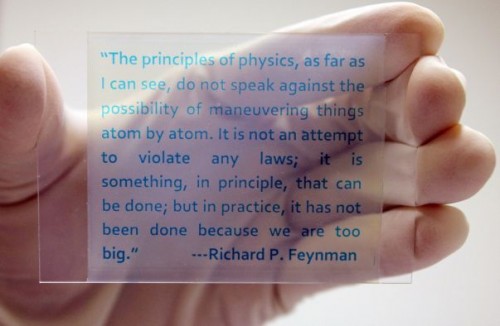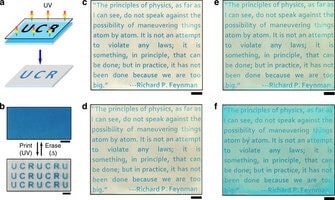Chemists at the University of California have developed an innovative paper that can be written on repeatedly, one based on the color-changing property of commercial chemicals known as redox-induced dyes. The coloring matter forms the inscription layer on the paper.

[Translation by Dr. Nachmani Moshe]
Chemists have developed an innovative paper that can be written on repeatedly, one based on the color-changing property of commercial chemicals known as redox (oxidation-reduction) dyes. The coloring matter forms the inscription layer on the paper.
According to some surveys, about 90% of all business information is currently conducted on paper, although the bulk of these printed documents are thrown into the trash after only one use. This paper waste (as well as the ink cartridges) - not to mention the environmental issues associated with it, such as deforestation and causing chemical pollution to the air, water and land - can be significantly reduced if it were possible to write or print on the paper several times, repeatedly.
Chemists from the University of California (Riverside) have now developed just such an innovative paper, and it is based on the ability to change the color of commercial chemicals called redox dyes. The coloring matter forms the inscription layer on the paper. The printing itself is obtained with the help of ultraviolet light projection which causes the photo-whitening of the color, except for the areas where the inscription will appear. The innovative paper can be erased and rewritten more than twenty times, without causing any significant deterioration in sharpness and resolution.
"This innovative rewritable paper does not need additional ink to print, a feature that makes it both cost-effective and less harmful to the environment," said Yadong Yin, the chemistry professor who led the study. "Our innovative paper presents an attractive alternative to ordinary paper and will be able to meet the rising global demands for sustainability and environmental preservation. The research findings were recently published in the scientific journal Nature Communications.
The paper used for repeated writing is basically a medium in the form of a thin layer of glass or plastic on which letters and patterns can be written and erased repeatedly by erasing them with simple heating. The paper comes in three main colors: blue, red and green, which are produced using the commercial acid dyes 'methylene blue', 'natural red' and 'acid green', respectively. Titanium nanocrystals (used as catalysts) and the hydrogenated cellulose thickener are integrated into the dye. This particular combination of the dye, the catalysts, and the cellulose derivative provides the layer with its high reversibility and reversibility.
During the writing phase, ultraviolet radiation causes the dye material to be reduced to its colorless state. During the erasing phase, re-oxidation of the reduced material restores the original color; That is, the writing material restores its original color with the help of a reaction with oxygen from the air. Heating the paper to a temperature of 115 degrees Celsius accelerates the reaction so that the erasing process is completed in less than ten minutes.
"The printed letters remain legible and in high resolution under normal conditions for more than three days - long enough for practical applications such as reading newspapers," said the lead researcher. "Furthermore, our innovative paper is simple to prepare, can be produced at low costs and has low toxicity and low energy consumption. "Even for this type of paper, heating it to a temperature of 115 degrees Celsius does not pose any problem," explains the researcher. "In normal laser printers, the paper is already heated to a temperature of 200 degrees Celsius today to cause the toner particles to bind to the surface of the paper."

The research team is working on increasing the number of cycles (the number of times the inscription can be printed and erased) with the goal being to reach a value of 100 cycles, in order to reduce the total production cost. In addition, the researchers are also trying to find ways with which it will be possible to extend the duration of reading the printed contents or images to more than three days, this is to expand the possible uses of such paper. "One of the ways is to develop new photocatalytic nanoparticles that undergo faster and more efficient redox when exposed to ultraviolet radiation," explains the lead researcher. "In addition, we are looking into the possibility of multi-color printing. Our design principle can be extended to other commercial Hamzor colors with the help of which it will be possible to get lettering samples in different colors. All these efforts should increase the number of practical applications of this technology.” Patent protection was requested for the new technology.
Recently, the research team synthesized a titania colloidal nanoparticle into which barium ions are embedded, which functions as a catalyst and enables a reversible color change in response to light, while obtaining a number of cycles and a high color change rate. "This improved performance originates from the more efficient removal of the photo-oxidized holes resulting from the introduction of barium ions into the material," explains the lead researcher.

5 תגובות
interesting
Safkan
You may be right, but I think you are wrong about one thing - the use of paper in the world is not decreasing at all. On the one hand, the export of paper has been stable for several years, on the other hand, the use of recycled paper is increasing (in my understanding), so the use of paper is on the rise.
This is quite logical because the number of businesses in the world is growing fast, while the actual paper savings are negligible. Just look at my inbox every morning…..
Oh, it even wrote that its existence is only 3 days (fades later). So no chance at all.
A waste of money. There will be no buyers because of the skyrocketing price of the paper to the consumer.
We will make do with traditional paper (the use of which is decreasing anyway) and tablets with handwritten arrangements (really unpopular to my surprise, maybe because of too high prices).